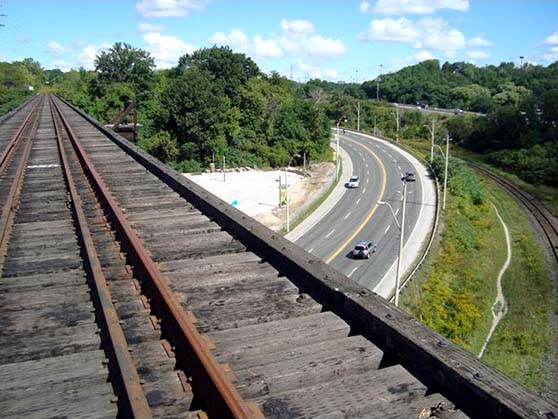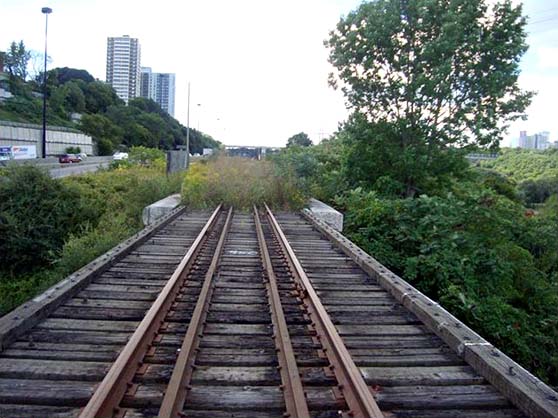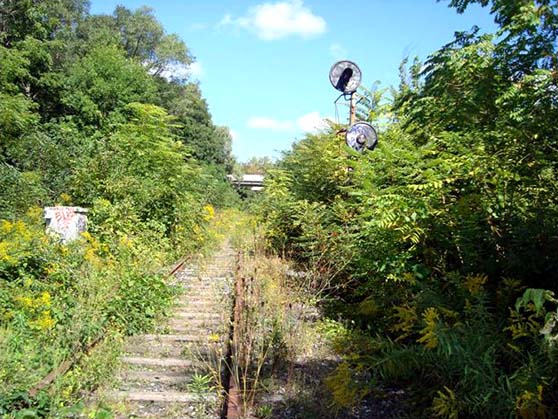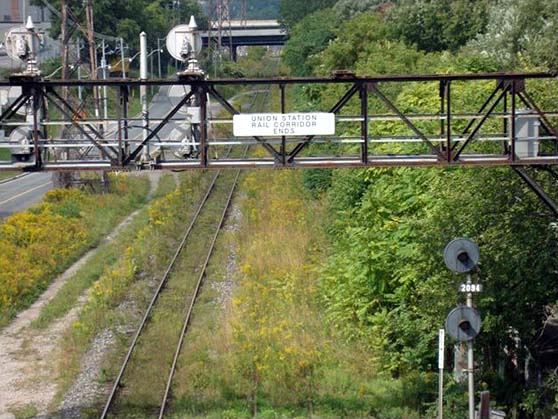
29 September 2010
A Walk Along the Don Valley Railway


Toronto Ontario - Imagine a five-kilometre stretch of Highway 401 somewhere between Toronto and
Montreal being closed?
It wouldn't happen.
But when a five-kilometre stretch of rail line, known as the Don Branch of the CPR Bellville subdivision closed a few years back, hardly anyone took notice,
until now.
First, a brief history of the Don Branch.
In 1888, the CPR was granted permission to build a branch line from Leaside Junction to Bay Street.
Prior to this route being laid, the CPR had no direct route into downtown Toronto.

Before the Don Branch, trains from Montreal and other eastern points were required to enter the city core by following a circuitous and perilous route.
Locomotives had to transverse the northern reaches of the city entirely, stopping at Leaside Junction, then moving on to West Toronto Junction, then reversing
five miles into Toronto's original Union Station.
Reversing?
This was because there were no curved lines leading from the westbound line to a southbound track.
Considering the numerous level crossings at the time, reversing a train into a city centre was dangerous.
The construction of the Don Branch was an obvious and successful solution.
Freight traffic opened on the Don Branch in 1892.
The following year, the railway corridor was opened to CPR passenger trains.
The corridor remained in use for over a century.
The final official train to travel the branch was CP's holiday train.
That was in December of 2007.

With the cessation of CP's passenger train service and a decline of industry within the city's core, the trains have stopped running, but the track is still in
place.
Getting to it by foot is possible at several locations.
Since the Don Branch runs a little over five kilometers, those interested in hiking the entire length of the branch might want to begin at the Leaside train
yard, which is located very near Millwood Avenue.
(Beware, though: the Leaside yard is an active yard. Trains enter and depart at regular interals. Just because the Don Branch is no longer in use doesn't
mean trespassing is permitted. The Leaside yard is routinely patrolled by CPR police.)
Soon after departing the Leaside yard, the Don Branch pulls hard in a southerly direction.
For reasons of safety, a length of track has been removed here to ensure the railroad remains unused.

Considering the track bed has been out of use for years, weed growth has began to reclaim the track bed.
Walking the track feels similar to viewing an episode of Life After People.
It is not uncommon to observe a fox trotting beside you, on one occasion, a handsome white-tailed buck was spied grazing on sumac leaves.
After about thirty minutes walking time from the Leaside Yard, the track leads to the half-mile bridge.
Up to this point, on account of its secluded nature, hiking down the track, it's easy to forget that one is actually hiking into the heart of a metropolitan city centre.
The bridge provides a reminder.
Gazing south and to the right of the bridge (which spans the Bayview Extension, the Don River, as well as on and off ramps to the Don Valley Parkway) is the
historic (and recently refurbished) Don Valley Brickworks.
This vantage point also affords a fantastic view of the downtown skyline.
A little about this bridge and a warning: even though it has always been referred to as the half-mile bridge, it is actually not that length at all.
At about 1,100 feet, or 335 metres, the half-mile bridge is really closer to a quarter-mile (1,320-foot) bridge.
But it's still not for the nervous.
If heights frighten you, follow this timely suggestion: hike down the valley wall to the newly opened Evergreen Brick Works and purchase some organic
vegetables.
While making the crossing, rest assured, it won't be necessary to yell train (in slow motion) like the character Gordie LaChance does in the film Stand By Me,
but the experience of crossing the long train bridge will remind anyone who has seen the film of that scene.
This is actually the second bridge the CPR constructed to span the expanse.
The bridge currently standing was erected in 1928.
Back then, with rolling stock increasing in size and weight, the original bridge required replacement, not an easy undertaking at the best of times.
Amazingly, engineers decided to attempt the rebuild without interrupting train service.
Here's how it was completed: in what would become train bridge construction lore, sections of the replacement bridge were constructed beside the original
bridge.
One after another, each section was replaced.
Keep in mind, this was performed in intervals, between the departure of the Montreal-bound morning train.
After it rolled past, workers would unbolt a section of bridge and a crane would remove said section, then a second crane would install the pre-assembled
section, securing it to a new concrete pier.
Passengers on the retuning Montreal-Toronto evening train would be none the wiser.
Making it all the more hazardous, construction was carried out seventy-five feet above the valley floor.
Leaving the half-mile bridge, the track now runs parallel to the Don Valley Parkway, but well below grade.
It is only possible to hear vehicles speeding by.
If each section of the Don Branch required naming, this portion would be known as Graffiti Alley.
For the next kilometre, the concrete retaining wall supporting the Parkway is a continuous canvas of graffiti.
Running twelve feet by approximately seventy-five feet is the sublime statement, "Stay Gold Toronto".
A touching sentiment few have the privilege to see so close.
Soon, the Don Branch passes beneath the very noisy Prince Edward Viaduct.
The subway rumbling above leaves one with the feeling that the entire structure might come crashing down.
Not to worry, it won't.
A little farther down the line, for only the second time, the track again crosses the Don River.
From here, the Don Branch begins to merge with the CN Bala subdivision line.
(Another caution: the Bala subdivision is not abandoned. It is CN's main transcontinental route and it carries heavy train traffic. GO Transit also uses
this route daily.)
The track then runs beneath a series of bridges.
First, there's the Riverdale pedestrian bridge, then Gerrard Street East, and, lastly, Dundas Street East.
The official terminus of the Don Branch is at the Queen Street bridge overpass.
The Don Station was once located here.
The track then connects southward to the Union Station Corridor.
Walking time for this journey takes just under two hours, but it may one day be much faster to get from one end to the other again.
In 2007, Metrolinx purchased the Don Branch.
GO Transit intends to (eventually) use the length of track to meet future ridership growth.
Additional material provided by Derek Boles.
Editor's Note: OKthePK web site does NOT condone trespassing on railway property. You may be subject to arrest and a fine.

|




